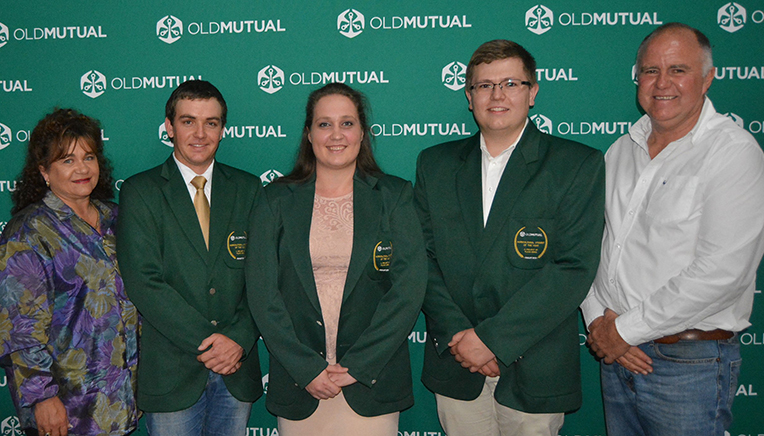The University of the Free State (UFS) once again produced winners at this year’s
Old Mutual Agricultural Student of the Year competition. Michelle Marais, honours student in the UFS
Department of Agricultural Economics, and Wian Visser, final-year BScAgric Agronomy student, were top scorers in the Agricultural Economics and Crop Production sections respectively.
Learning from the bestApart from the opportunity to compete in their field of study, Michelle and Wian also benefited from the expertise of industry leaders in agricultural economics, animal science, and crop production. They had the opportunity to learn from Dr John Purchase (Agbiz), Dr Dirk Strydom (
Grain SA), and Gerhard Schutte (Red Meat Producers’ Organisation), who acted as industry partners and judges during the competition.
Michelle always had a particular interest in the development of emerging farmers and plans on doing her master’s degree in Agricultural Economics, focusing on emerging wool farmers. “Beyond that, I hope to get an opportunity to work finding solutions to some of the problems facing development in agriculture,” she said.
Wian also plans on completing his master’s. “Thereafter, I would like to enter the workforce and help the current and future producers to farm better in a changing environment. The ideal would be to remain in a research-oriented position while working full time,” he said.
Participating with the UFS in this competition, were
Stellenbosch University (producing the overall winner in the Animal Science section, Pieter Theron), the University of Fort Hare, North-West University, and the University of Pretoria. As with last year’s competition, the students first had to compete in an initial round at their respective universities, after which eleven finalists went through to the final round held during the ALFA expo at the Afridome in Parys.
Rewarded for hard workThe winners were announced during a gala dinner at the expo. Besides a green blazer and R1 000 prize money, Michelle and Wian also received an Old Mutual investment portfolio worth R5 000. They furthermore gained exposure on Grootplaas and RSG Landbou and in Plaas Media’s magazines Veeplaas, Stockfarm, and FarmBiz.

The three winners in this year’s Old Mutual Agricultural Student of the Year Competition. From the left are Riana Grobler, Marketing Manager at Old
Mutual, Pieter Theron of Stellenbosch University, Michelle Marais and Wian Visser, both from the University of the Free State, and Albert Loubser of
Plaas Media. (Photo: Plaas Media)
According to Dr Frikkie Maré, Academic Head of the Department of Agricultural Economics (UFS), the Old Mutual Agricultural Student of the Year competition provides the ideal opportunity for universities to showcase the quality of their Agricultural students, and thus the quality of their teaching and research practices.
He said: “In the two years that the competition was hosted, the UFS managed to win the Agricultural Economics and Animal Science divisions in 2018, and the Agricultural Economics and Plant Production divisions in 2019. We have thus been able to win all three categories over the two years, which can only serve as an indication that the UFS is indeed one of the top Agricultural Science universities in the country.”
Preparing for the workplaceWian and Michelle both agree that they have received more than just the exposure and funding.
In her own words, Michelle described the value added: “This competition challenged me to become more aware of current events within the politics, policy, and economic development in the country and the influence on our specific industry. The opportunity to present my findings and opinions on current issues in agriculture to several industry leaders, challenged me to combine the theoretical knowledge gathered in my four years of study with my practical experiences. Applying it to real-world problems and finding possible solutions helped me to realise that I could not have asked for better preparation in the workplace.”
According to Wian, the competition presented him with the opportunity to develop his networking skills and a chance to express his opinion in a professional environment. “It broadened my perception on agriculture by exposing me to different entities in the agricultural community. I also saw different methods and approaches in the sector that I am not necessarily familiar with,” he said.
Wian believes the UFS has one of the best agricultural faculties in the country and that staff put a lot of effort into preparing students for the world of work. “The Department of Agronomy encourages critical thinking, an essential skill in an ever-changing work environment,” said Wian. He added: “Assessments are not only theoretical, but practical. These practical skills are related to the work required in a work environment. The department also exposes its students to companies, resources, and contacts that are helpful for networking when one enters the workforce.”
According to Michelle, the Department of Agricultural Economics also play their part in preparing students for the job market. “Our assignments always challenged us to contact people in the industry, to do industry research, and to plan practically,” she said.
Old Mutual has been involved as the name sponsor of this Plaas Media competition since 2018 and has played an active role in promoting and developing the competition.